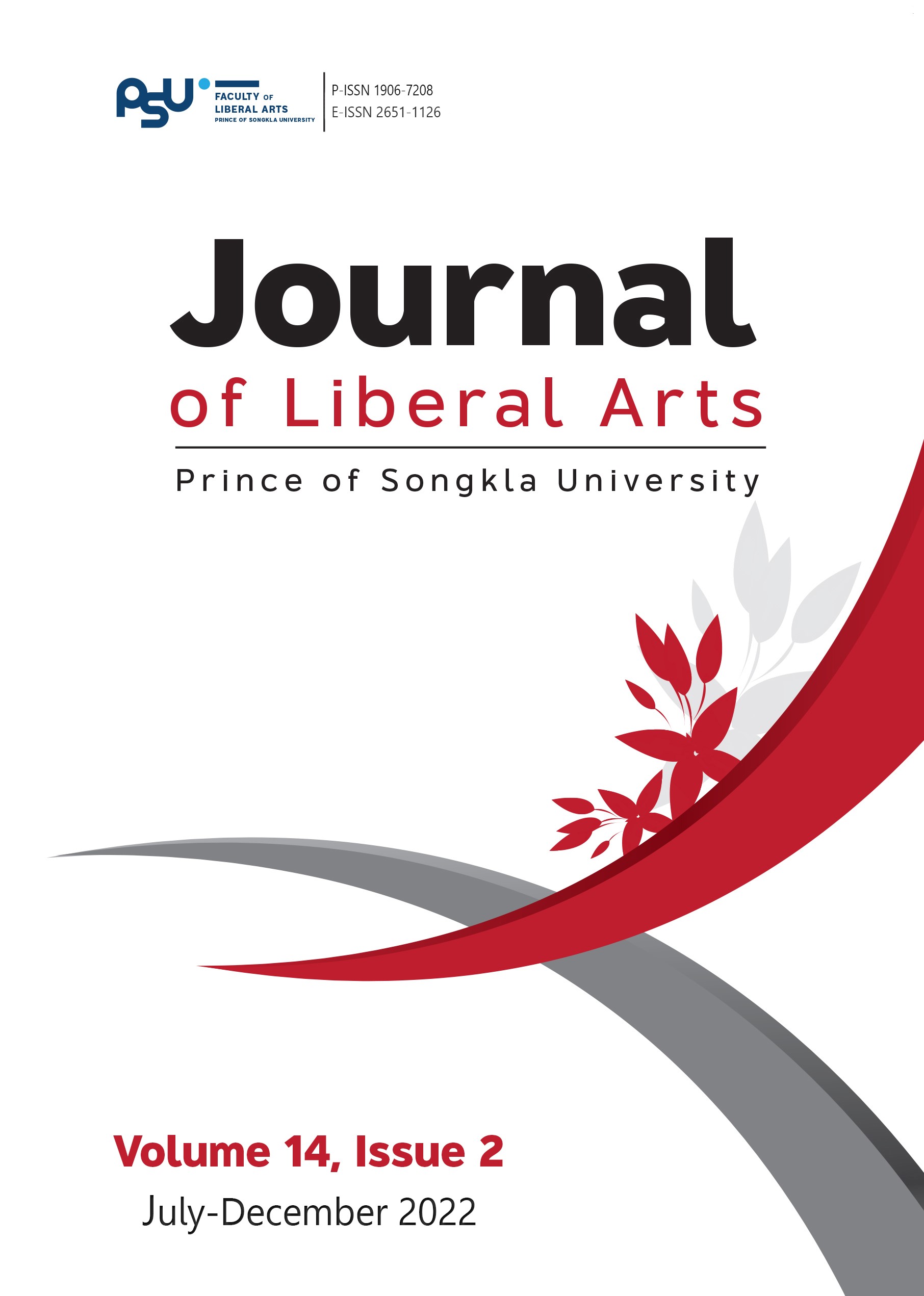What Makes “The Phantom” a Phantom? : Characterizations of The Phantom in The Phantom of the Opera through Literary and Criminological Perspectives
DOI:
https://doi.org/10.14456/jlapsu.2022.15Keywords:
characterization, criminology, causes of crime, The Phantom of the OperaAbstract
This research aims to study the characterizations ofThe Phantom in The Phantom of the Opera written by Gaston Leroux through literary and criminological perspectives. The elements are explored in terms of types, naming, traits, and presentation techniques, while factors in the etiology of the character’s criminal behavior are analyzed by applying integrated criminological theories. The study discusses the characterization of The Phantom in the narrative and factors that influence the creation of this character as a phantom, a frightening criminal. The findings are presented in tables and descriptive explanations. The results show that The Phantom is a round and dynamic character taking the role of a villain and a protagonist. Each aspect of characterization, including naming, and external and internal traits of the character presented through narrations, dialogues, and actions, altogether play a part in characterizing The Phantom. In addition, the character had criminal behaviors such as intimidation, abduction, and murder, motivated by an inferiority complex of not being accepted by society, being labeled, and lack of social bonds.
References
Adler, A. (2013). The science of living (psychology revivals)(1st ed.). Routledge. https://doi.org/10.4324/9780203386750
Alshiban, A. S. (2013). Exploring criminology in literary texts: Robert Browning – an example. Jordan Journal of Modern Languages and Literature, 5(1), 57-70.
Botting, F. (1996). Gothic. Routledge.
Bernburg, J. (2009). Labeling Theory. In M.D. Krohn, A. Lizotte & G.P. Hall (eds.), Handbook on crime and deviance
(pp. 187-207). Springer. https://doi.org/10.1007/978-1-4419-0245-0_10
Chatman, S. (1978). Story and discourse: Narrative structure in fiction and film. Cornell University Press.
Culpeper, J. (2002). A cognitive stylistic approach to characterisation. In E. Semino & J. Culpeper (eds.), Cognitive stylistics: Language and cognition in text analysis (pp. 251-277). John Benjamins Publishing.https://doi.org/10.1075/lal.1.13cul
De Temmerman, K. (2014). Crafting characters: Heroes and heroines in the ancient Greek novel. Oxford University Press. https://doi.org/10.1093/acprof:oso/9780199686148.001.0001
Fludernik, M. (2009). An introduction to narratology (P. Häusler-Greenfield and M. Fludernik, Trans.). Routledge. https://doi.org/
4324/9780203882887
Forster, E. M. (1927). Aspects of novel. Harcourt, Brace & Company.
Garvey, J. (1978). Characterization in narrative, Poetics, 7(1), 63-78.
Griffin A.M., & Langlois J.H. (2006). Stereotype directionality and attractiveness stereotyping: Is beauty good or is ugly bad? Social Cognition, 24(2), 187–206. https://doi.org/10.1521/soco. 2006.24.2.187
Herman, L., & Vervaeck, B. (2005). Handbook of narrative analysis. University of Nebraska Press.
Hapsari, A., Rosnija, E., & Wardah, W. (2022). An analysis on the characterization of the main character in the Phantom
of the Opera’s film. Jurnal Pendidikan dan Pembelajaran Khatulistiwa, 11(1). 1-9. http://dx.doi.org/10.26418/jppk. v11i1.51769
Hidayanti, C.P. (2015). Erik’s oppression in Gaston Leroux’s The Phantom of the Opera. LITERA KULTURA: Journal of Literary and Cultural Studies, 3(2). https://doi.org/10.26740/lk.v3i2.12666
Hogle, J. E. (2016). The undergrounds of The Phantom of the Opera: Sublimation and the Gothic in Leroux's Novel
and its progeny. Palgrave Macmillan. https://doi.org/10.1007/978-1-137-11288-0
Hume, R. D. (1969). Gothic versus romantic: A revaluation of The Gothic Novel. PMLA, 84(2), 282-290.
https: //doi.org/10.2307/1261285
Karali, S. N. (2020). Musical affect and the emotion–cognition interaction in The Phantom of the Opera. Neohelicon, 47, 249–263. https://doi.org/10.1007/s11059-020-00525-2
Kavaler-Adler, S. (2009). Object relations perspectives on “Phantom of the Opera” and its demon lover theme: The modern film. The American Journal of Psychoanalysis, 69(2), 150-166.
Lee, C. (2013). The ghost-image on metropolitan borders—In terms of Phantom of the Opera and 19th-century metropolis paris. Societies. 4(1), 1-15. https://doi.org/10.3390/soc4010001
Leroux, G. (2017). The Phantom of the Opera (A. Teixeira de Mattos, Trans.). Arcturus Publishing Ltd.
Miller, J. (2009). 21st century criminology: A reference handbook. SAGE Publications, Inc.https://doi.org/10.4135/9781
Pellegrini, L. P. (2010). Le Fantôme de l Opéra novels evolution its theatrical cinematic adaptations in 20th century Spazio Tesi. LED Edizioni Universitarie.
Propp, V. (1968). Morphology of the folktale. University of Texas Press.
Raharto, R.D., & Permatasari, R. (2019). The protagonist’s shadow and persona as the reflection of anti-hero in The Phantom of
the Opera novel retold by Diane Namm. EduLite: Journal of English Education, Literature and Culture. 4(1), 65-75. http://dx.doi.org/10.30659/e.4. 1.65-75
Schmid, W. (2012). Implied author. In P. Hühn, et al. (Eds.), The living handbook of narratology (pp. 136-146). Hamburg University Press.
Schreck, C. J., & Hirschi, T. (2009). Social control theories. In J. M.Miller (Ed.), 21st century criminology: A reference handbook (pp. 305-311). SAGE Publications, Inc.https://doi.org/10.4135/9781412971997.n35
Siegel, L. J. (2010). Criminology: Theories, patterns, and typologies (10th Ed.). Wadsworth/Cengage Learning.
Sternfeld, J. (2015).Pitiful creature of darkness”: The subhuman and the superhuman in The Phantom of the Opera. In
B.Howe, S. Jensen-Moulton, N. Lerner & J.Straus (Eds.), The Oxford handbook of music and disability studies (pp. 795–814). Oxford University Press.
Tobia, A., Dobkin, R.D., Ilaria, S., Aziz, R., Bisen, V., & Trenton, A.J. (2017). The Phantom of the Opera: A case study of severe major depressive disorder with psychotic features. Journal of Depression & Anxiety, 6, 1-4.
Trippany-Simmons, R., Buckley, M., Meany-Walen, K., & Rush-Wilson, T. (2014). Individual psychology: Alfred Adler.
In R. Parsons & N. Zhang (Eds.), Counseling theory: Guiding reflective practice (pp. 109-139). SAGE Publications, Ltd. https://dx.doi.org/10.4135/9781483399621.n5
Watt, I. P. (1957). The rise of the novel: Studies in Defoe, Richardson, and Fielding. Chatto & Windus.
Wellek, R., & Warren, A. (1956). Theory of literature [by] René Wellek and Austin Warren. Harcourt, Brace & World.Wellford, C. F. (2009). History and evolution of criminology. In J. M. Miller (Ed.), 21st-century criminology: A reference handbook (pp. 10-17). SAGE Publications, Inc..
Windt-Val, B. (2012). Personal names and identity in literary contexts. Oslo Studies in Language, 4(2), 273–284. https://doi.org/10.5617/osla.324
Downloads
Published
How to Cite
Issue
Section
License
Copyright (c) 2022 Kanittha Suwannapracha

This work is licensed under a Creative Commons Attribution-NonCommercial-NoDerivatives 4.0 International License.
The authors retain the copyright to their article but the Journal of Liberal Arts, Prince of Songkla University reserves the exclusive rights to first publication.






